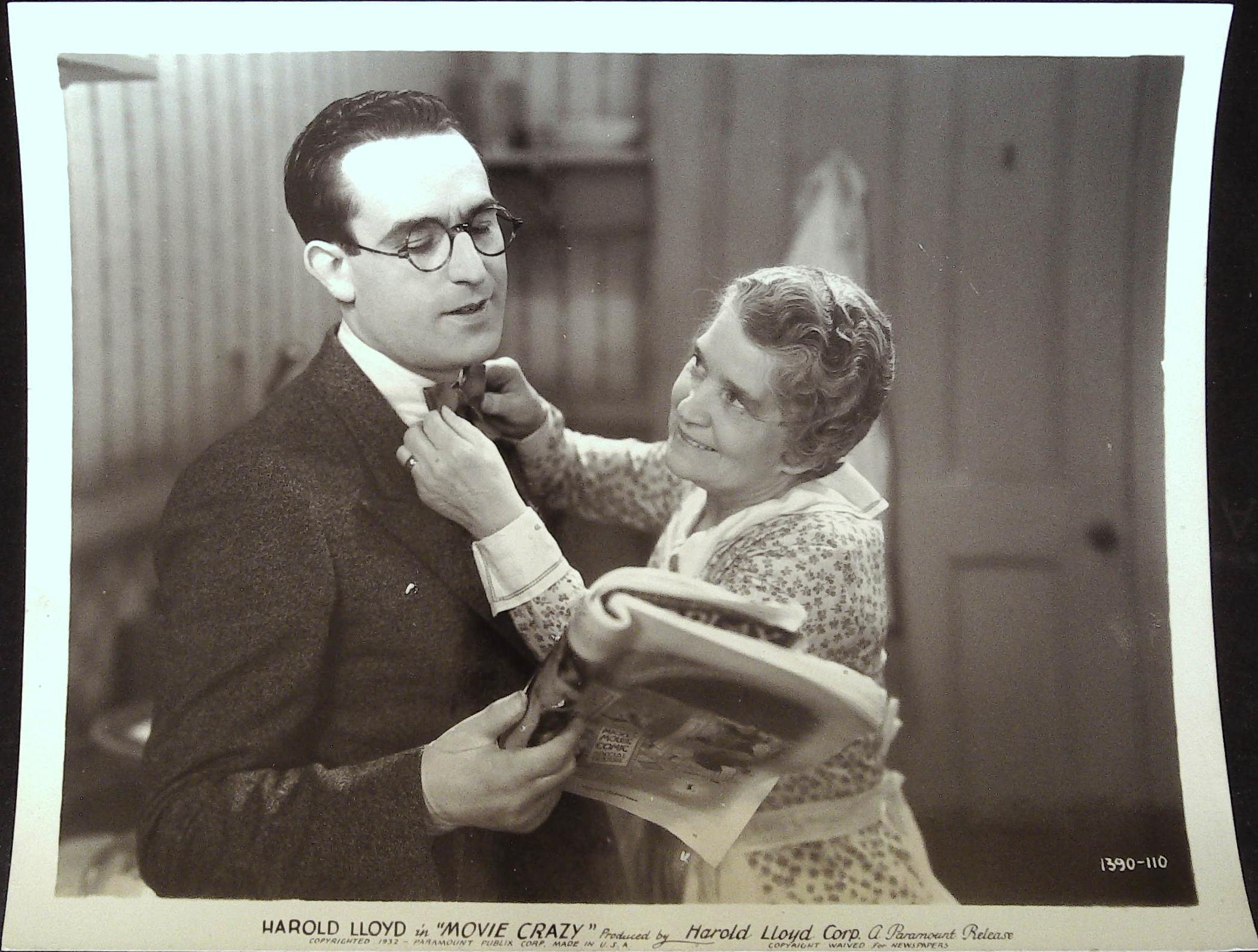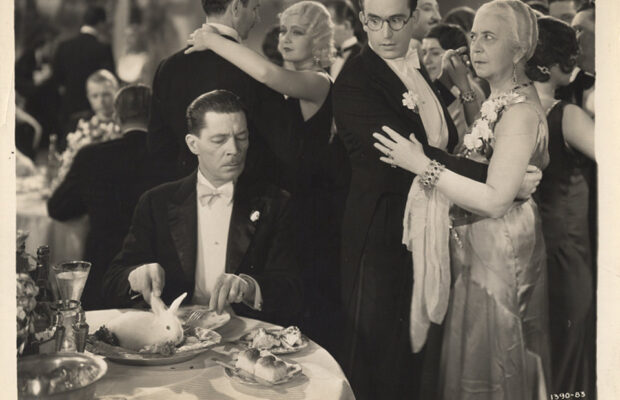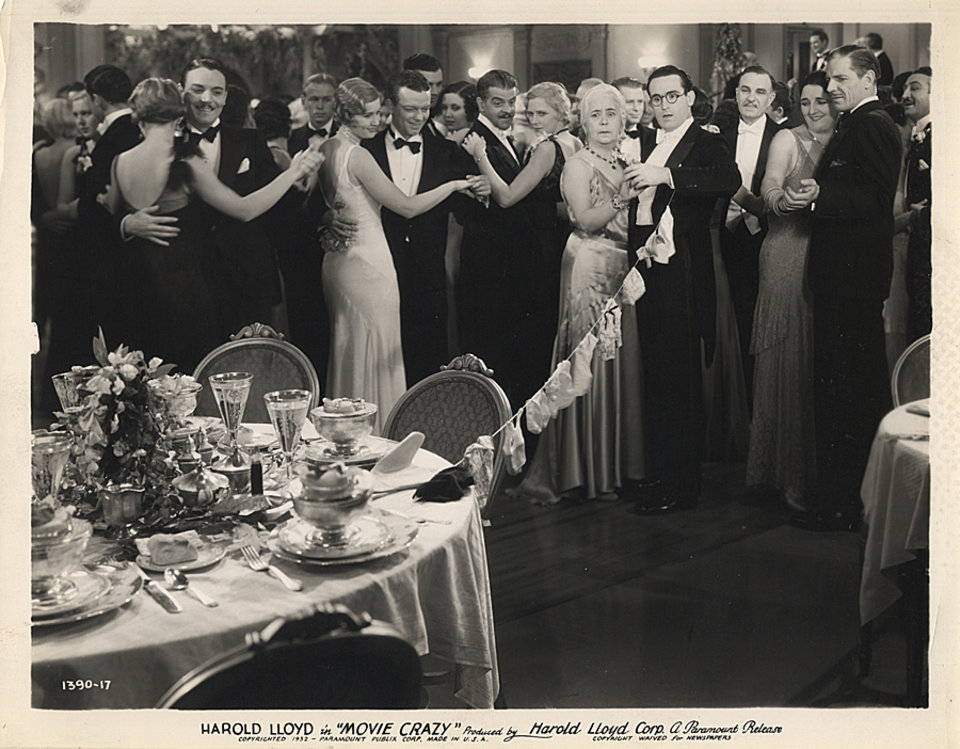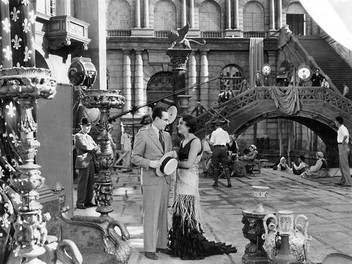Eu amo filmes. E os filmes que eu mais amo são filmes sobre filmes. Eu considero “Crepúsculo dos Deuses” (1950) o melhor filme já feito, meu filme favorito de todos os tempos é “Nasce uma Estrela” de 1937 e eu também amo profundamente “Fazendo Fita” (1928). Por isso eu não poderia deixar passar a oportunidade de ver e escrever sobre “Cinemaníaco” (1932), que não é apenas um filme sobre filmes que conversa comigo, mas também aquele que é considerado o melhor filme falado de Harold Llloyd.
I love movies. And the movies I love the most are movies about movies. I consider “Sunset Boulevard” (1950) to be the best movie ever made, my favorite movie of all times is “A Star is Born” from 1937 and I also love deeply “Show People” (1928). That’s why I couldn’t miss the opportunity to watch and review “Movie Crazy” (1932), not only a movie about movies that talks to me, but also a film that’s considered Harold Lloyd’s best sound picture.
Começando com uma divertida gag visual que poderia ter sido usada nos filmes mudos, “Cinemaníaco” conta a história de Harold (Lloyd), para quem o cinema é tudo. Sua mãe (Lucy Beaumont) concorda com isso, mas seu pai (DeWitt Jennings) não gosta muito – da mesma maneira que meu avô não gostava muito da minha “mania”. Harold manda uma carta e uma foto para um chefe de estúdio, mas em vez de sua foto ele acaba anexando a imagem de outra pessoa. Ele é chamado para Hollywood e, sem saber do erro, lá vai ele!
Starting with a fun visual gag that could have been used in silent films, “Movie Crazy” tells the story of Harold (Lloyd), for whom cinema is everything. His mother (Lucy Beaumont) is OK with it, but his father (DeWitt Jennings) is unimpressed – the same way my grandfather wasn’t impressed with my “mania”. Harold sends a letter and a picture to a studio head, but instead of his picture he ends up annexing someone else’s photo. He is called to Hollywood and, not knowing the mistake, here he goes!
Assim que desembarca em Hollywood, Harold atrapalha uma cena que está sendo filmada, mas seu destino é a Planet Film Corporation, onde o Sr O’Brien (Spencer Charters) está esperando alguém diferente. O encontro deles é tempestuoso, como esperado, mas Harold tenta escapar – algo que não combina com seu desejo de se tornar astro do cinema.
Harold messes up with a scene being shot the moment he sets foot in Hollywood, but his final destination is Planet Film Corporation, where Mr O’Brien (Spencer Charters) is expecting someone different. Their meeting is tempestuous as expected, but Harold tries to escape – something that doesn’t match his desire to become a movie star.
Durante uma tempestade, Harold conhece Mary Sears (Constance Cummings). O primeiro contato é confuso por causa das trapalhadas de Harold, mas eles logo se tornam amigos. Mas eles já haviam se conhecido anteriormente: Mary é a atriz do filme que estava sendo rodado quando Harold chegou a Hollywood, e ele não a reconheceu porque ela usava uma peruca de cabelos negros no set de filmagem. No dia seguinte no estúdio, Mary está novamente usando a peruca e chama a atenção de Harold ao falar com um forte sotaque espanhol. Mary decide então brincar com a confusão da dupla identidade.
During a storm, Harold meets Mary Sears (Constance Cummings). Their beginning is shaky because of Harold’s clumsiness, but soon they become friends. But they had met before: Mary is the actress from the movie that was being shot when Harold first arrived in Hollywood, and he couldn’t recognize her because she was wearing a black wig on set. The following day at the studio, Mary is also wearing the wig and calls Harold’s attention by speaking with a heavy Spanish accent. Mary then decides to play with the mistaken identities.
Uma das minhas coisas favoritas em filmes sobre filmes é ver a fábrica de sonhos em ação, isto é, os bastidores de um estúdio de cinema. Também é ótimo ver alguém atuando mal de propósito. Você precisa ser um ator muito bom para atuar mal e fazer isso ser engraçado, mas não ridículo. O objetivo é a risada, não a vergonha.
One of my favorite things in movies about movies is seeing the dream factory in action, that is, the backstage of a film studio. It’s also great to see someone playing a bad actor. You’ve got to be a very good actor to act badly and make it funny but not ridiculous. The goal is the laugh, not the cringe.
No começo da crítica eu escrevi que a gag que abre o filme poderia ter sido usada no cinema mudo. O mesmo se prova verdade para muitas outras gags, como o sapato que é arrastado pela correnteza até o bueiro ou o cigarro que queima a cabeça de um homem calvo. As muitas trapalhadas causadas quando Harold veste a jaqueta de um mágico também funcionariam num filme mudo. A briga no clímax é tirada diretamente dos filmes mudos – de fato: a sequência é um remake de uma semelhante em “O Caçula” (1927), também de Lloyd.
In the beginning of the review I said that the gag that opens the film could have been used in silent cinema. The same is true to many other gags, like the shoe being taken by the rain to the sewer and the cigarette burning a bald man’s head. The many shenanigans caused by Harold wearing a magician’s jacket instead of his own also would work in a silent film. The climatic fight is another element taken directly from silent movies – and in fact it was: the sequence is a reworking of a similar one from Lloyd’s “The Kid Brother” (1927).
“Cinemaníaco” é interessante para falar sobre diversidade no cinema. Há um personagem interpretado por Grady Sutton que é claramente gay – ou melhor, afeminado – porque ele sobe numa mesa e grita como uma mulher quando diversos ratos correm pelo chão durante um jantar chique. Há também dois personagens negros, a empregada de Mary, Besssie, e o valete no banheiro masculino. Ele é interpretado por Sam McDaniel, que não recebe crédito, enquanto a atriz que faz Bessie permanece não identificada no IMDb. Outro toque moderno, com ares feministas: o admirador de Mary, Vance (Kenneth Thomson), um ator bêbado, é um homem violento que diz em alto e bom tom que a mataria para que ela não namorasse outra pessoa.
“Movie Crazy” is interesting to talk about diversity in film. There is a character played by Grady Sutton that is clearly coded as gay – or rather, effeminate – because he goes up a table and screams like a woman while several rats are running around on the floor during a dinner party. There are also two black characters, Mary’s maid Bessie and the men’s restroom valet. He is played by an uncredited Sam McDaniel, while the actress who plays Bessie remains unidentified on IMDb. Another modern touch, with feminist undertones: Mary’s admirer Vance (Kenneth Thomson), a drunk actor, is a violent man who says out loud that he would kill her to prevent her from dating someone else.
O diretor é Clyde Bruckman, também responsável pela continuidade. Um bem-sucedido escritor, Bruckman co-escreveu obras-primas como “Bancando o Águia” (1924) e “A General” (1926). Ele dirigiu 21 filmes, incluindo curtas de O Gordo e o Magro e os dois primeiros filmes falados de Harold Lloyd. Apesar de creditado como diretor, durante as filmagens de “Cinemaníaco” Bruckman esteve constantemente incapacitado por causa da bebida e Harold Lloyd teve de dirigir a maioria das cenas. Bruckman usou material de “Cinemaníaco” em seu último filme, “Conquistando a Muque” (1945) e foi processado por Lloyd por não ter lhe dado crédito. Em desgraça, Bruckman cometeu suicídio em 1955.
The director is Clyde Bruckman, who is also responsible for continuity. An accomplished writer, Bruckman co-write masterpieces such as “Sherlock Jr” (1924) and “The General” (1926). He directed 21 movies, including Laurel & Hardy shorts and Harold Lloyd’s first two talkies. Despite being credited as director, during the making of “Movie Crazy” Bruckman was often incapacitated by his alcoholism and Harold Lloyd had to direct most scenes. Bruckman used material from “Movie Crazy” in his last film, “She Gets Her Man” (1945) and was sued by Lloyd because of the lack of credits. Discredited, Bruckman committed suicide in 1955.
O diretor assistente é Gaylord Lloyd, irmão mais velho de Harold. Seu primeiro filme como ator foi em 1916 e em muitas ocasiões ele foi dublê do irmão, pela similaridade física, e comumente não recebia créditos. Gaylord tem cinco créditos como diretor assistente entre 1927 e 1932, todos em filmes de Harold.
The assistant director is Gaylord Lloyd, Harold’s older brother. His first film as an actor was in 1916 and in many occasions he doubled for his brother, with whom he looked a lot alike, and he was often uncredited. Gaylord had five credits as assistant director between 1927 and 1932, all in Harold’s films.
“Cinemaníaco” foi feito por Lloyd para a Paramount. Ele havia trabalhado com Hal Roach desde 1914, quando desenvolveu o personagem Lonesome Luke. Harold e Roach seguiram caminhos diferentes em 1924, quando o comediante criou a Harold Lloyd Film Company, distribuindo seus filmes primeiro através da Pathé, depois através da Paramount.
“Movie Crazy” was made by Lloyd for Paramount. He had been working with Hal Roach since 1914, when he developed the Lonesome Luke character. Harold and Roach parted in 1924, when the comic created the Harold Lloyd Film Company, distributing his films first through Pathé, then through Paramount.
Eu sou como a personagem de Harold Lloyd: Cinemaníaca. Mas, ao contrário dele e de tantos cinemaníacos, nunca tive vontade de fazer filmes. Assitir e escrever sobre eles é o que me faz feliz – e o que me salvou. Eu escrevi sobre como os filmes me salvaram em meu primeiro livro infantojuvenil, “Menina Bonita com Mania de Fita”, cujas ilustrações da talentosa Clara Assis evocam Marion Davies no já mencionado “Fazendo Fita”. Meu livro está disponível na Amazon.
I’m like Harold Lloyd’s character: Movie Crazy. But, unlike him and so many movie crazy people, I never got the urge to appear in or make movies. Watching them and writing about them is what makes me happy – and what saved me. I wrote about how movies saved me in my first children’s book, “The Movie Crazy Pretty Girl”, whose illustrations by the talented Clara Assis evoke Marion Davies in the aforementioned movie about movies “Show People”. My book is available on Amazon.











No comments:
Post a Comment